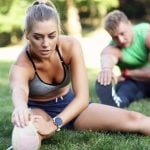What are some fitness exercises for upper body? Upper body strength is crucial for overall health and fitness. It not only enhances muscle tone and strength but also plays a vital role in functional movements and posture. In this article, we will discuss the importance of upper body fitness, the benefits of upper body workouts, and provide a comprehensive list of exercises for targeting the upper body.
Working out the upper body offers a wide range of benefits beyond just improving muscle tone. It can also lead to better posture, increased overall strength, and enhanced functional movement abilities. Whether you’re looking to build muscle or simply improve your overall health, incorporating upper body workouts into your fitness routine is essential.
In the following sections, we will delve into the best upper body exercises, including both equipment-free options like push-ups and pull-ups, as well as exercises that utilize weights such as chest presses. Additionally, we will provide tips for safely training the upper body to prevent injury and discuss how to incorporate these workouts into a well-rounded fitness routine alongside lower body and core exercises.
Benefits of Upper Body Workouts
Working out the upper body offers a multitude of benefits that contribute to overall health and wellness. By targeting muscles in the arms, shoulders, back, and chest, upper body exercises can lead to improved posture, increased strength, and enhanced functional movement.
Improved Posture
One of the key benefits of upper body workouts is the improvement of posture. Strengthening the muscles in the upper back and shoulders can help counteract the effects of slouching and sitting for prolonged periods. By developing these muscle groups, individuals can stand taller with their shoulders pulled back, reducing strain on the neck and lower back.
Increased Strength
Engaging in regular upper body workouts also leads to increased strength throughout the arms and chest. This enhanced strength not only improves physical performance but also contributes to everyday activities such as carrying groceries or lifting objects. Stronger arms and shoulders also provide added stability during various movements.
Enhanced Functional Movement
Incorporating upper body exercises into a fitness routine can also enhance functional movement patterns. Functional movements involve activities that mimic real-life motions, such as reaching, pushing, pulling, and lifting. By strengthening the muscles involved in these movements through targeted exercises like push-ups and pull-ups, individuals can improve their overall capacity for functional tasks.
Best Upper Body Exercises
When it comes to upper body strength and fitness, there are numerous exercises that can effectively target different muscle groups. Push-ups are a classic bodyweight exercise that engages the chest, shoulders, triceps, and core. This compound movement is not only versatile but can also be modified to increase or decrease resistance based on individual fitness levels.
Another effective upper body exercise is pull-ups, which primarily target the back, biceps, and forearms. Pull-ups require a pull-up bar or other sturdy overhead structure for execution and provide an excellent way to build upper body strength and muscular endurance.
Chest presses are also essential for developing strength in the chest, shoulders, and triceps. This exercise can be done using dumbbells, barbells, or weight machines and offers variations such as incline presses or decline presses to target specific areas of the chest. Additionally, incorporating shoulder exercises like overhead presses or lateral raises into a workout routine can help improve shoulder stability and definition. These exercises engage the deltoid muscles for increased strength and endurance.
Incorporating these exercises into a well-rounded fitness routine can lead to improved upper body strength, enhanced posture, and increased functional movement. Whether aiming to build muscle mass or simply looking to enhance overall upper body fitness, these exercises offer versatility and scalability for individuals at all levels of training.
| Exercise | Muscles Targeted |
|---|---|
| Push-ups | Chest, Shoulders, Triceps, Core |
| Pull-ups | Back, Biceps, Forearms |
| Chest Presses | Chest, Shoulders, Triceps |
| Shoulder Exercises (Overhead Presses/Lateral Raises) | Deltoids (Shoulder Muscles) |
Equipment-Free Upper Body Exercises
When it comes to working out the upper body, many people believe that expensive equipment or a gym membership is necessary. However, there are plenty of effective upper body exercises that require no equipment at all. These exercises not only target the muscles in your arms, shoulders, and chest but also engage the core for added stability and balance.
Tricep Dips
Tricep dips are a great bodyweight exercise for strengthening the triceps, which are important for pushing movements and overall arm strength. To do tricep dips, find a stable surface like a chair or bench and sit on the edge with your hands placed next to your hips.
Lift your body off the seat with your arms straight, then lower yourself by bending your elbows until they reach a 90-degree angle. Push yourself back up to starting position using your triceps.
Plank Variations
Planks are well-known for their ability to target the core, but they also engage the muscles in the shoulders and arms. To add an upper body focus to planks, you can incorporate variations such as forearm planks, side planks, or plank shoulder taps. These variations force the arms and shoulders to support more of your body weight and provide an excellent workout for those muscle groups.
Shoulder Taps
Shoulder taps are an effective exercise for building stability in the shoulders while engaging the core muscles as well. Start in a high plank position with hands directly under your shoulders. Lift one hand off the ground and tap it to the opposite shoulder while keeping your hips level without rotating them. Then switch to tap the other shoulder with the opposite hand. This movement challenges both arm strength and core stability simultaneously.
Incorporating these equipment-free upper body exercises into your fitness routine can help you build strength and improve muscle tone without needing any special equipment. Whether you’re working out at home or want to add variety to your gym sessions, these exercises offer an effective way to target your upper body muscles.
Upper Body Exercise With Weights
When it comes to upper body workouts, incorporating weights can significantly enhance the effectiveness of your training routine. The benefits of using weights for upper body exercises include increased muscle strength, improved muscle tone, and enhanced resistance against gravity. Dumbbells and resistance bands are versatile tools that can be utilized for a wide range of upper body exercises targeting different muscle groups.
One of the key advantages of incorporating weights into upper body workouts is the ability to progressively overload the muscles. This means that as your muscles adapt and grow stronger, you can increase the weight or resistance to continue challenging them, leading to further gains in strength and muscle development. Additionally, using weights for upper body exercises can help improve bone density, which is essential for overall bone health and reducing the risk of osteoporosis.
Here are some examples of effective upper body exercises using dumbbells or resistance bands:
1. Bicep curls: Hold a dumbbell in each hand with your arms extended by your sides, then slowly curl the weights towards your shoulders while keeping your elbows stationary.
2. Bent-over rows: With a dumbbell in each hand and your knees slightly bent, lean forward from the hips with your back straight and perform rowing motion by bringing the elbows up and back.
3. Chest press with resistance bands: Securely anchor the resistance band behind you at chest level and hold one end in each hand. Extend your arms forward at shoulder height, then press them out in front of you until they are straight.
These are just a few examples of how incorporating weights into upper body workouts can elevate your training routine by providing greater resistance and challenge to effectively target various muscle groups.
| Benefits | Examples |
|---|---|
| Increased muscle strength | Bicep curls |
| Improved muscle tone | Bent-over rows |
| Enhanced bone density | Chest press with resistance bands |
These exercises are just a starting point for integrating weights into your upper body workouts. As always, it’s crucial to maintain proper form, start with an appropriate weight for your fitness level, and gradually progress as you become stronger. If done correctly, incorporating weights into your upper body training regimen can lead to noticeable improvements in strength, muscular endurance, and overall fitness level over time.
Remember that variety is key when it comes to exercising different parts of the body; including variety in intensity (the heaviness of those dumbbells or intensity levels) might help those muscles adjust positively too.
Upper Body Routines
For those looking to improve their upper body strength and overall fitness, incorporating targeted workout routines for the upper body is essential. Whether you are a beginner just starting out on your fitness journey or an advanced gym-goer looking to challenge yourself, there are specific exercises and routines tailored to different fitness levels that can help you achieve your fitness goals.
For beginners, it’s important to start with basic exercises that target the major muscle groups in the upper body. This can include modified push-ups, assisted pull-ups using resistance bands, and light dumbbell chest presses. These exercises help to build a foundation of strength and prepare the body for more challenging workouts as you progress.
Intermediate level individuals can add more variations and intensity to their upper body workout routines. This may involve incorporating exercises such as diamond push-ups, chin-ups, and incline dumbbell presses. Additionally, increasing the amount of weight lifted or the number of repetitions can provide an effective workout for those at an intermediate fitness level.
Advanced individuals who have been consistently working out their upper body may benefit from more complex exercises that require greater strength and stability. These can include plyometric push-ups, muscle ups, and one-arm dumbbell rows. It’s also important for advanced individuals to vary their routines and incorporate different training methods in order to continue challenging their muscles for optimal growth and strength.
No matter what your fitness level may be, customizing your upper body routine based on your current abilities will help you see progress while minimizing the risk of injury. The key is to gradually increase the intensity and difficulty of your workouts as you become stronger and more proficient in performing these exercises.
Tips for Safely Training the Upper Body
When it comes to training the upper body, safety should always be a top priority. Proper form and technique are essential for preventing injuries during workouts. Here are some important tips for safely training the upper body:
- Warm Up: Before starting any upper body workout, it’s important to warm up the muscles to prevent strains and injuries. Engage in dynamic stretching and light cardio exercises to prepare the body for the upcoming workout.
- Focus on Form: Whether you’re doing bicep curls, shoulder presses, or any other upper body exercise, maintaining proper form is crucial. Avoiding jerky movements and using controlled, deliberate motions will not only reduce the risk of injury but also ensure that you’re targeting the intended muscles effectively.
- Gradually Increase Intensity: Overtraining the upper body can lead to fatigue and overuse injuries. It’s important to gradually increase the intensity of your workouts over time, allowing your muscles to adapt and become stronger without putting them at risk for strain or injury.
In addition to these tips, it’s also important to listen to your body and take rest days when needed. Proper nutrition and hydration are also critical for supporting your body during upper body workouts. By following these safety guidelines, you can maximize the benefits of your upper body exercises while minimizing the risk of injury.
Ultimately, incorporating proper safety measures into your upper body training routine will allow you to strengthen and tone your muscles effectively while reducing the likelihood of setbacks due to injury. Taking a mindful and cautious approach to your workouts will help ensure that you can continue reaping the benefits of a strong and healthy upper body for years to come.
Incorporating Upper Body Workouts Into Your Fitness Routine
When considering what are some fitness exercises for upper body, it’s important to remember that a holistic approach to fitness is key. This means not neglecting the lower body and core in favor of solely focusing on the upper body. By incorporating exercises such as squats, lunges, deadlifts, and planks into your workout routine, you can improve stability, balance, and overall functional movement. Additionally, engaging in full-body workouts can promote better posture and alignment while preventing muscle imbalances.
In conclusion, while upper body workouts are essential for improving strength and functional movement, it’s vital to incorporate a holistic approach to fitness by balancing these exercises with lower body and core workouts. By doing so, you can achieve overall muscular development, improve stability and balance, and reduce the risk of injury. Remember to prioritize proper form and technique while performing any exercise for optimal results in your fitness journey.
Frequently Asked Questions
What Exercise Is Best for Upper Body?
The best exercise for the upper body would be a combination of different movements that target the arms, shoulders, chest, and back. This could include exercises like push-ups, pull-ups, shoulder presses, and rows.
What Are 6 Upper Body Exercises?
Some examples of upper body exercises include push-ups, pull-ups, bicep curls, tricep dips, shoulder presses, and chest flys. These exercises work different muscle groups in the upper body to build strength and endurance.
Is 5 Exercises for Upper Body Enough?
Whether 5 exercises for the upper body are enough depends on various factors such as individual fitness goals, intensity of the exercises, and frequency of workouts. For some people, 5 well-chosen exercises may be sufficient to strengthen and tone their upper bodies, while others may benefit from a more varied or comprehensive routine.

Passionate about providing useful information to anyone with an interest in the field of Personal Training, I strive to pass on to our readers quality information and to answer any questions about Personal Trainers, the work they do and how to become one.





